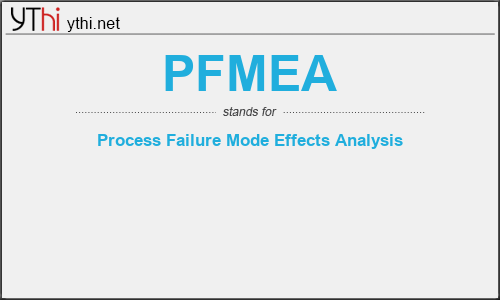What does PFMEA mean? What is the full form of PFMEA?
The Full Form of PFMEA is Process Failure Mode Effects Analysis.
Failure mode and effects analysis (FMEA; often written with “failure modes” in plural) is the process of reviewing as many components, assemblies, and subsystems as possible to identify potential failure modes in a system and their causes and effects. For each component, the failure modes and their resulting effects on the rest of the system are recorded in a specific FMEA worksheet. There are numerous variations of such worksheets. An FMEA can be a qualitative analysis, but may be put on a quantitative basis when mathematical failure rate models are combined with a statistical failure mode ratio database. It was one of the first highly structured, systematic techniques for failure analysis. It was developed by reliability engineers in the late 1950s to study problems that might arise from malfunctions of military systems. An FMEA is often the first step of a system reliability study.
STEP 1: Review the process
- Use a process flowchart to identify each process component.
- List each process component in the FMEA table.
- If it starts feeling like the scope is too big, it probably is. This is a good time to break the Process Failure Mode and Effects Analysis into more manageable chunks.
STEP 2: Brainstorm potential failure modes
- Review existing documentation and data for clues about all of the ways each component can failure.
- The list should be exhaustive – it can be paired down and items can be combined after this initial list is generated.
- There will likely be several potential failures for each component.
STEP 3: List potential effects of each failure
- The effect is the impact the failure has on the end product or on subsequent steps in the process.
- There will likely be more than one effect for each failure.
STEP 4: Assign Severity rankings
- Based on the severity of the consequences of failure.
STEP 5: Assign Occurrence rankings
- Rate the severity of each effect using customized ranking scales as a guide.
STEP 6: Assign Detection rankings
- What are the chances the failure will be detected prior to it occuring.
STEP 7: Calculate the RPN
- Severity X Occurrence X Detection
STEP 8: Develop the action plan
- Decide which failures will be worked on based on the Risk Priority Numbers. Focus on the highest RPNs.
- Define who will do what by when.
STEP 9: Take action
- Implement the improvements identified by your Process Failure Mode and Effects Analysis team.
STEP 10: Calculate the resulting RPN
- Re-evaluate each of the potential failures once improvements have been made and determine the impact of the improvements.
PFMEA
means
Process Failure Mode Effects Analysis![]()
Translate Process Failure Mode Effects Analysis to other language.


Leave a Reply
You must be logged in to post a comment.